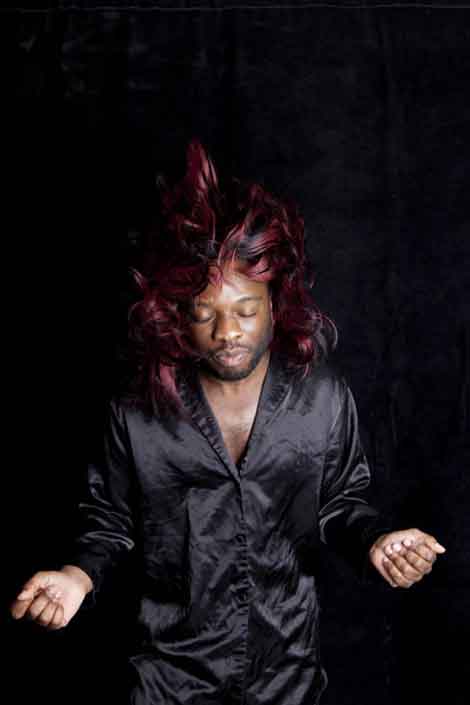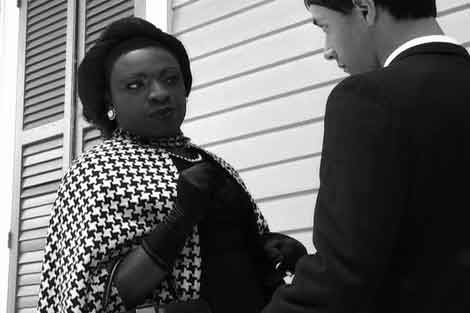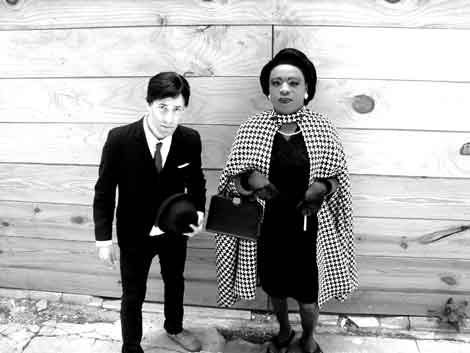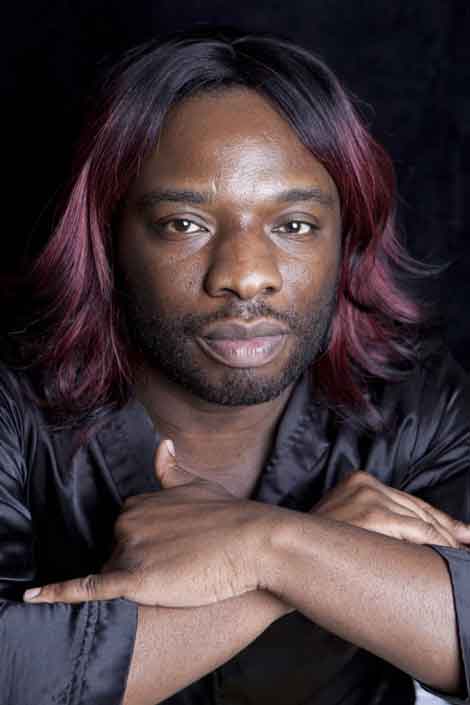The mid-afternoon New York City traffic is uncharacteristically brisk on my way to interview performance artist Kalup Linzy. I arrive in Crown Heights, Brooklyn, half an hour early, with my photographer. Linzy greets us at his unmarked live-in work-space basement studio wearing a shiny dark gray satin shirt, white boxer shorts with orange and brown hibiscus flowers and a pair of rubber flip-flops.
Welcoming us in, he exclaims, “I know I told you 2 p.m., because The Bold and the Beautiful goes off at 2 o’clock.” Linzy pauses, “I mean, I can make exceptions.”
I am grateful, because this man is serious about his soaps. His most acclaimed work is a series of self-made soap opera videos, some of which are All My Churen, Da Young and da Mess and the ongoing serial “Conversations Wit de Churen.” They are equal parts gender-bending satire, daytime high drama and genuine heartfelt homage.
Before excusing himself, Linzy announces that he’s going to make some popcorn because he has the munchies. He returns with a bag of microwave popcorn, wearing a brunette shoulder-length fuchsia-tipped wig. We want to take photos outside to catch some of the early spring light, but Linzy objects, “I can’t be going out like this; school will be getting out soon. I don’t want that kind of attention. You know how some high school boys can be.” He pauses, then adds, “But of course I’ll beat their ass!” The threat is difficult to believe. There is an easy grace about him: his newly added tresses framing his deep soulful eyes, his wide soft smile caressing the scruff of his beard.
The wigs, high fashion and glamour that have become a hallmark of Linzy’s work don’t necessarily define his real world. “I’m not transgender; it’s not a lifestyle for me. I just use the aesthetic of drag in my work, but I don’t think I’m a drag artist either. I just decided consciously that whenever I was going to appear that I would be dressed up and performing because I think of myself as a guy who is pretty boring,” he says laughing. “I mean, that’s what the work is, but I didn’t necessarily want to be my characters from the videos. People are annoyed that it isn’t real, but I’m like ‘whatever — get ready!’ As people misunderstand, they’ll research my work more. There are many layers to a man putting on a dress. We’re all drag queens and drag kings, anybody who’s performing to create an identity.”
Linzy’s identity seems delightfully complex. He counts his influences as everything from daytime dramas, old black-and-white Hollywood movies, the romanticism of the Harlem Renaissance to Def Comedy Jam and the sitcoms of his childhood. He draws artistic inspiration from Andy Warhol, John Waters, Glenn Ligon and Lyle Ashton Harris. Munching on a handful of popcorn, Linzy muses, “When I was in college I had this Black Male Body book. I remember that exact moment I saw Lyle Ashton Harris, in like a tutu. I connected that to John Waters in my mind, and that sort of began to give me the freedom to do my work.”
Despite Linzy’s rather grand ascension into the art-world elite, he seems fairly unaffected by it. “I feel like the world is my art community anywhere I go. You hang out with the people that you’re around and working with and let the energy come and go. It’s like a fleeting experience. But I really do feel like the world is my home.” One of the “elite” that Linzy has been hanging out with recently is actor James Franco. They met in 2009 when Linzy was performing at a party for Art Basel Miami Beach. Last year, Franco asked Linzy to join him on General Hospital during his stint playing a deranged artist/serial killer, Robert “Franco” Frank. In an art-imitates-life twist, Linzy played Franco’s musical collaborator singer and performance artist, Kalup Ishmael.
This was a “full-circle moment” for Linzy: “I grew up wanting to be on a soap opera. I grew up wanting to be a filmmaker, a director and wanting to sing. I incorporate all this stuff into my art. So when somebody comes along like James Franco and says, ‘You wanna be on General Hospital?’, of course I’m going to say yes. The whole point of me doing the videos is because I didn’t think a soap opera could ever happen to someone like me. I didn’t believe it at first, but then I was like, ‘Oh my gosh, this is really happening!’” Linzy is grinning. “It was a big event in my life! I had to rethink, because it really wasn’t supposed to happen in a million years. Especially because I had decided to be openly gay and not give a shit and instead just express it through my work. But it gave me the confidence to do more and follow more of my dreams.”
Linzy is reflective when talking about those early years growing up in Clermont, Florida. “When I started making art in my late 20s, I was confronted with things that I had missed or was missing, things I needed to confront and deal with. Like I grew up — my mother didn’t raise me. She was schizophrenic and on drugs for a period of time. I realized I had abandonment issues, but I would not deal with them. Moving to New York made me look that in the face. Just to really look at it and know how it affected things I did. It made me want to be a giver, to feel good about something. There are certain things that I didn’t get, and so I became more inclined when I was making my work to make something just for myself, or people who are like me to identify with and enjoy.”
Upon first impression, Linzy’s work may seem like zany high-camp performance art. It’s challenging to watch his soap opera video series and not get sucked in by the characters. You immediately want to tune in to the next episode and see how it all plays out — a common soap opera strategy. “In comedy, the tragedy happens first, and then the journey back from that is normally humorous, you know, to try to heal it,” Linzy says.
High and low art brazenly crash into each other in Linzy’s work; any notion or division between the two is unimportant to him. While grateful for his success, he is unimpressed by art-world politics. “I remember being at MoMA, and I basically told the audience that I didn’t care what they thought, and I think people probably didn’t appreciate it too much, but I felt like I had to set myself free from these other people’s opinions. All they talked about was these crack addicts in the ’80s, but my mother was one. They talk about being gay, but I am one of them. They talk about being black, but that was me. Everything I felt I was a part of was being marginalized. I had to set myself free from all these opinions to be able to live.” Linzy pauses, becomes quiet and crumples up the popcorn bag. “It’s not the easiest thing. I think it’s important to care, but you have to have some kind of detachment at particular points in order to just survive and not emotionally kill yourself. The work became about my own healing and hopefully other people get something from that. I’ve done a good job with it. I’ve grown, and I’ve learned. It’s okay to let go of things you didn’t get and not dwell on it … and it’s okay to be liked. Everything doesn’t have to be so heavy all the time, you know. Early on I was just doing things so I could be accepted, but now my work is really about accepting myself.”
Linzy gets up and loads a dance mix on his laptop; the music floods the room. Suddenly we’re all up on our feet dancing and laughing. His words echo in my mind: “Everything doesn’t have to be so heavy all the time.” The photo shoot begins. Linzy serves up a powerful supermodel turn to the camera with an “I’ll beat your ass” diva glint in his eye, and suddenly I can plainly see a man in a wig who can take care of business if and when he needs to.
Greg Walloch is a writer and performer in Los Angeles. For more information, visit www.GregWalloch.com.





